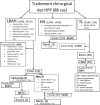[Which surgical strategy to adopt for the management of postpartum haemorrhage and how to improve the effects of hypogastric arteries ligation?]
- PMID: 28292059
- PMCID: PMC5325502
- DOI: 10.11604/pamj.2016.25.96.9242
[Which surgical strategy to adopt for the management of postpartum haemorrhage and how to improve the effects of hypogastric arteries ligation?]
Abstract
The objective were to identify the success factors of bilateral hypogastric arteries ligation and to assess its role in surgical treatment of postpartum hemorrhages. We conducted a retrospective study of all the cases of postpartum hemorrhage requiring surgical treatment between January 2008 and December 2011. The study included 88 patients (0,47% of all births). Uterine atony was the most common etiology (64,8 % of patients). Bilateral ligation of the hypogastric arteries was performed in 81.8% of patients. When surgery was the first choice treatment, its success rate was 66%. This rate was variable depending on the etiology of hemorrhage, the presence or the absence of hemostasis disorders and the time between diagnosis and surgical treatment. In case of uterine atony, the association with a second conservative technique, when the first was inadequate, helped stop the bleeding in 98% of cases. Ligation of hypogastric arteries is an effective surgical technique for the treatment of postpartum hemorrhage. Its success rate has increased thanks to early implementation and to the association with other conservative techniques.
L'objectif était d'identifier les facteurs de succès de la ligature bilatérale des artères hypogastriques et évaluer sa place dans le traitement chirurgical des hémorragies du post-partum. Nous avons réalisé une étude rétrospective regroupant tous les cas d'hémorragie du post-partum ayant nécessité un traitement chirurgical entre Janvier 2008 et Décembre 2011. L'étude a concerné 88 patientes (0,47% du total des accouchements). L'atonie utérine était l'étiologie la plus fréquente (64,8 % des patientes). La ligature bilatérale des artères hypogastriques a été réalisée chez 81,8% des patientes. Quand elle était le premier geste chirurgical réalisé, son taux de succès était de 66%. Ce taux était variable en fonction de l'étiologie de l'hémorragie, de la présence ou non de troubles de l'hémostase et du temps écoulé entre le diagnostic et la réalisation du geste chirurgical. En cas atonie utérine, l'association d'une deuxième technique conservatrice lorsque la première était insuffisante, a permis d'arrêter le saignement dans 98% des cas. La ligature des artères hypogastriques est une technique chirurgicale efficace pour le traitement de l'hémorragie du post-partum. Son taux de succès est augmenté par sa réalisation précoce ainsi que son association à d'autres techniques conservatrices.
Keywords: Haemostatics brace suturing; Hemostasis hysterectomy; Ligation of hypogastric arteries; Postpartum hemorrhage; Vascular ligation.
Conflict of interest statement
Les auteurs ne déclarent aucun conflit d'intérêts.
Figures
References
-
- Hogan MC, Foreman KJ, Naghavi M, et al. Maternal mortality for 181 countries, 1980-2008: a systematic analysis of progress towards Millennium Development Goal 5. Lancet. 2010;375(9726):1609–23. - PubMed
-
- Mahbouli S, Basli M, Messaoudi F, et al. Maternal mortality: epidemiology, risk factors and evitability: About ten cases. Gynecol Obstet Fertil. 2003;31(12):1018–23. - PubMed
-
- Deneux-Tharaux C, Bonnet M-P, Tort J. Epidemiology of post-partum haemorrhage. J Gynecol Obstet Biol Reprod (Paris). 2014;43(10):936–50. - PubMed
-
- Tsirulnikov MS. Ligation of the uterine vessels during obstetrical hemorrhages: immediate and long-term results (author's transl)] J Gynecol Obstet Biol Reprod (Paris). 1979;8(8):751–3. - PubMed
-
- O'Leary JA. Uterine artery ligation in the control of postcesarean hemorrhage. J Reprod Med. 1995;40(3):189–93. - PubMed
MeSH terms
LinkOut - more resources
Full Text Sources


